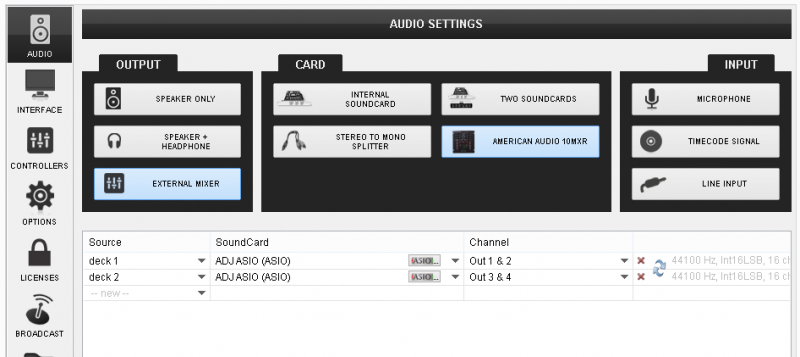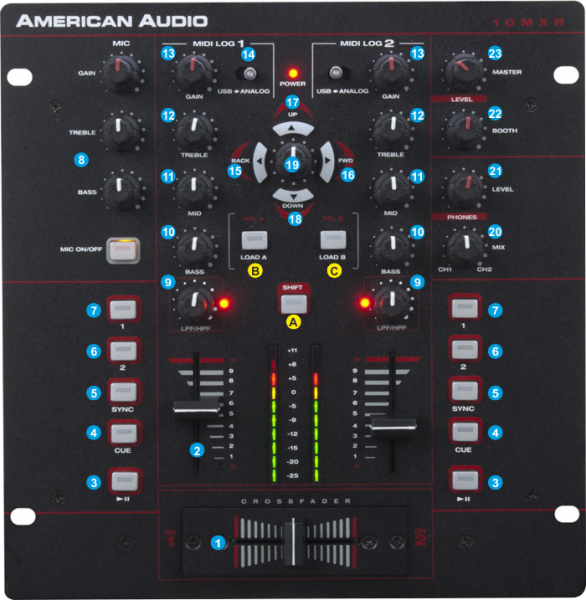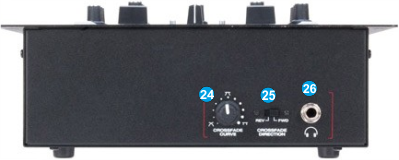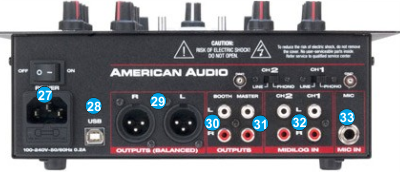AMERICAN AUDIO 10MXR

SETUP
Firmware: No firmware update is available at the time that this document was written, however you should always check at the manufacture website.
Drivers (for Windows only): Install the latest ASIO drivers from http://www.adj.com/10-mxr
No drivers are required for Mac OSX computers.
VirtualDJ 8 Setup
Once VirtualDJ 8 is launched, a Login Window will appear. Login with your virtualdj.com account.
A Pro Infinity, a PLUS or a Pro Subscription License is required to fully use the American Audio 10MXR. Without any of the above Licenses, the controller will operate for 10 minutes each time you restart VirtualDJ.
http://www.virtualdj.com/buy/index.html
The 10MXR is also coming bundled with VirtualDJ LE. In this case download and install the Limited Edition from http://www.virtualdj.com/le

A detection window will appear next, asking to use or not the pre-defined audio setup. This can be also changed later from the AUDIO tab of VirtualDJ Settings.
Click on the Use Soundcard button and VirtualDJ will auto-create the necessary audio configuration.
Click to OK.

The unit is now ready to operate.
Advanced Setup
AUDIO Setup
The Audio configuration is pre-defined and offered in the Audio tab of Settings as a special button in the CARD tab. Press this button and then click on APPLY to auto-create the following audio configuration.

Note that the 10MXR is an analogue dj mixer and the audio routing is handled by the unit. Even though movements of most of the mixer faders and knobs are visible on VirtualDJ GUI when used, the EQ, the Filter and the mixer functions are hardware operations (VirtualDJ internal mixer is not used).
MIDI Operation
The unit should be visible in the CONTROLLERS tab of Config and the factory default mapping should be available and pre-selected in the Mappings drop-down list. The factory default Mapping offers the functions described in this Manual, however those can be adjusted to your needs via VDJ Script actions.

For further software settings please refer to the User Guide of VirtualDJ 8.
http://www.virtualdj.com/manuals/virtualdj8/index.html
CONTROLS

Several functions for the buttons and knobs of the 10MXR depend on the various offered modes.
A. SHIFT. Press this button once and release to enable the SHIFT Toggle mode. The Led of the SHIFT button will blink as an indication.
Press and hold the SHIFT button down to access temporary SHIFT actions of various buttons.
B. LEFT LOAD. Press this button to load the selected track to the left VirtualDJ deck. Press the same button for more than 1 second to unload the same deck. The Led will be on if the deck is loaded.
Hold SHIFT down and press this button to enable the Sampler mode. Repeat this to turn the mode off. In Sampler mode the Led will blink as an indication.
C.RIGHT LOAD. Press this button to load the selected track to the right VirtualDJ deck. Press the same button for more than 1 second to unload the same deck. The Led will be on if the deck is loaded.
Hold SHIFT down and press this button to enable the FX mode. Repeat this to turn the mode off. In Effects mode the Led will blink as an indication.
- CROSSFADER. Blends audio between the channels assigned to the left and right side of the crossfader.
- VOLUME. Adjust the Volume of left and right deck.
- PLAY/PAUSE. Plays / Pauses the left or right deck. Press and hold Shift and then press this button to play the track in reverse.
- CUE. When the Deck is paused, you can set a temporary Cue Point. During playback, you can press the Cue Button to return the track to this Cue Point. (If you did not set a Cue Point, then it will return to the beginning of the track.). If the Deck is paused, you can press and hold the Cue Button to play the track from the Temporary Cue Point. Releasing the Cue Button will return the track to the temporary Cue Point and pause it. To continue playback without returning to the Temporary Cue Point, press and hold the Cue Button, then press and hold the Play Button, and then release both buttons.
Press and hold SHIFT and then press this button to return to the beginning of the track. - SYNC. Press this button to automatically match the corresponding Deck's tempo with the opposite Deck's. Press and hold SHIFT and then press this button temporary speed up the tempo of the track (pitch bend)
- CUE2. Assigns a Hot Cue Point Nr.2 or returns the track to that Hot Cue Point. When the button is unlit, you can assign Hot Cue Nr.2 by pressing it at the desired point in your track. Once it is assigned, the button will be lit.
- [list]
- In Shift toggle mode (SHIFT blinks) press this button to delete Hot Cue Nr.2.
Press and hold SHIFT and then press this button to smoothly reset pitch to zero position. - In Sampler mode, use this button to trigger the 2nd Sampler slot. Hold SHIFT down and then press this button to stop the same Sampler slot. If the SHIFT toggle mode is enabled (SHIFT blinks), use this button to trigger the 4th Sampler slot. Hold SHIFT down and then press this button to stop the same Sampler slot.
If the selected Bank has less than 4 samples, both sides will control the same Sampler slot. If the selected bank has more than 5 samples, the left side will trigger slots 2 or 4 and the right side will trigger slots 6 or 8.
- CUE1. Assigns a Hot Cue Point Nr.1 or returns the track to that Hot Cue Point. When the button is unlit, you can assign Hot Cue Nr.1 by pressing it at the desired point in your track. Once it is assigned, the button will be lit.
- [list]
- In Shift toggle mode (SHIFT blinks) press this button to delete Hot Cue Nr.1.
Press and hold SHIFT and then press this button to temporary slowdown the tempo of the track (pitch bend). - In Sampler mode, use this button to trigger the 1st Sampler slot. Hold SHIFT down and then press this button to stop the same Sampler slot. If the SHIFT toggle mode is enabled (SHIFT blinks), use this button to trigger the 3rd Sampler slot. Hold SHIFT down and then press this button to stop the same Sampler slot.
If the selected Bank has less than 4 samples, both sides will control the same Sampler slot. If the selected bank has more than 5 samples, the left side will trigger slots 1 or 3 and the right side will trigger slots 5 or 7.
- MIC SECTION. Turn on/off, adjust the Gain and the Equalizer (2 Bands) of the Microphone Input. This section is not controlling or affecting the Microphone Input of VirtualDJ (Hardware operation)
- LPF/HPF. The knob controls a Hardware (Internal) Low/High Pass Filter. Push the encoder to turn on/off the applied filter.
- BASS (EQ). Adjust the Low frequencies for each Midilog/deck. The internal Equalizer of VirtualDJ is not used (Hardware operation), however movements will be visible on VirtualDJ GUI.
- MID (EQ). Adjust the Middle frequencies for each Midilog/deck. The internal Equalizer of VirtualDJ is not used (Hardware operation), however movements will be visible on VirtualDJ GUI.
- TREBLE (EQ). Adjust the High frequencies for each Midilog/deck. The internal Equalizer of VirtualDJ is not used (Hardware operation), however movements will be visible on VirtualDJ GUI.
- GAIN. Adjust the Gain of each Midilog/deck. The applied gain is not altering the software gain of the internal VirtualDJ mixer, however the movement will be visible on VirtualDJ GUI.
- MIDILOG SWITCH. Turn the switchers to the USB position to allow the Midilog Channel to control the left and right VirtualDJ decks.
Turn the switcher to ANALOGUE position to use a Midilog as an analogue input source. In this position the sound of the VirtualDJ deck will be muted. - BACK. Sets the focus to the previous window of VirtualDJ Browser.
- [list]
- In Sampler mode press this button to select the previous Sampler Bank.
- In FX mode press this button to enable the Video Transition control (default selection)
- FWD. Sets the focus to the next window of VirtualDJ Browser.
- [list]
- In Sampler mode press this button to select the next Sampler Bank.
In FX mode press this button to enable the Master Video Effect control.
- UP. Cycle through the center panels of the default VirtualDJ GUI (Mixer, Video, Scratch and Master). Press and hold SHIFT and then use this button to open/close the Info window of VirtualDJ Browser.
- [list]
- In Sampler mode use this button to select the next available Sampler Trigger mode (On/off, Hold, Stutter and Unmute)
- DOWN. Cycle through the available views of the Sideview of VirtualDJ Browser (Automix, Sampler, Sideview, Karaoke and Clone). Press and hold SHIFT down and then use this button to open/close the Sideview of VirtualDJ Browser.
- [list]
- In Sampler mode, the button offers the Sampler view of SideView.
- BROWSE ENC. Scrolls through files or folders. If the Folders list of Browser is focused, push the encoder to open/close the subfolders. If any other window is focused, push the encoder to load the focused track to the default/selected deck of VirtualDJ.
- [list]
- In Sampler mode the encoder controls the Master Volume Output of Sampler.
- In FX mode, the encoder will select the Video Transition or the Master Video Effect, depending on the selection of the BACK (15) and FWD (16) buttons.
Push the encoder to trigger the selected Video Transition of Master Video Effect.
Press and hold SHIFT down and then use the encoder to control the 1st parameter of the selected Video Transition or Master Video Effect.
Press and hold SHIFT down and then push the encoder to open/close the GUI of the selected Video Transition or Master Video Effect.
- HEADPHONES MIX. Adjust how the mixer Channels blend at the Headphones Channel. Hardware operation, but movement visible on the VirtualDJ GUI (via the PFL buttons). When the knob is at the far left position (0%), only Channel 1 will be routed to the Headphones Channel, and when at the far right position (100%), only channel 2 will be routed to the Headphones Channel. In all other positions, both Channels will be routed.
- HEAPHONES LEVEL. Adjust the Volume Output of the Headphones Channel. Hardware operation, but movement visible on the GUI.
- BOOTH VOLUME. Adjust the level of the Booth Output. Hardware operation (handled by the unit).
- MASTER VOLUME. Adjust the level of the Master Output. Hardware operation (handled by the unit) but movement visible on the VirtualDJ GUI.
FRONT & REAR PANEL


- CROSSFADER CURVE. Define how the crossfader will blend the channels depending on its position (from Smooth to Cut/Scratch curves).
- CROSSFADER DIRECTION. Reverses the direction of the crossfader. If set to REV, the left Channel will be heard when the crossfader is at the right side and the right Channel to the other side.
- HEADPHONES SOCKET. Plug your Headphones to this socket.
- POWER. AC Power Socket and AC Power Switcher.
- USB Connection for the MIDI Operations of the 10MXR.
- MASTER BALANCED OUTPUT.(XLR)
- BOOTH OUTPUT. Use this connection to either connect a speaker monitor or send the Output to a Recording Input.
- MASTER UNBALANCED OUTPUT. (RCA)
- MIDILOG INPUTS. Connect analogue sources (Turntables, CD players etc) or use these Inputs for Timecode (DVS) or Recording Inputs.
- MIC INPUT. Microphone Input Socket
RECORD & TIMECODES
Recording & Broadcasting
The American Audio 10MXR does not offer the ability to record or broadcast your mixing internally. However, recording & broadcasting (including the Microphone inputs) is possible by following the way described below.
- Connect the Booth Output with either Inputs CH1 or CH2, using a proper 2XRCA cable.
- Head to the AUDIO tab of VirtualDJ Settings and add a record line to the audio configuration and select the Inputs Channels 1&2 or 3&4 (depending on which Input CH the Booth Output is routed).

Timecodes
The American Audio 10MXR offers the ability to use Timecode CDs or Vinyls (DVS).
- Connect your Timecode CD players or turntables with the Inputs of CH 1 and CH2 using proper 2xRCA cables.
- Head to the AUDIO tab of VirtualDJ Settings, and click on the Timecode button in the Input tab.
The following audio configuration will be created and the Timecode on/off buttons will appear on the VirtualDJ GUI. - Click APPLY.

